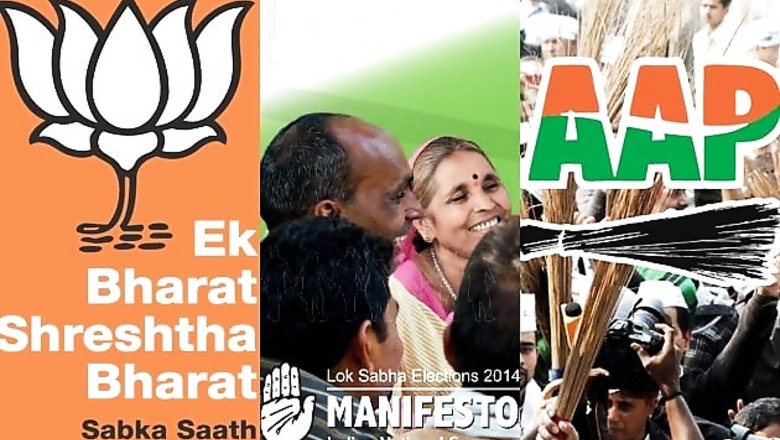
views
If the first round of polls are any indication, the high voter turnout signals a rising awareness among voters to assert their right as active citizens in Indian democracy. Will the remaining rounds of polls continue this trend? If they do, it would be clearly indicative of the intensity of interest that this election has evoked among the people across the country. The 2014 polls have been distinct in many respects. If one looks at how the major players have approached this election, it provides an indication of their strategy and electoral game plan.
For the Congress party it was clearly going to be an election where they were required to vigorously defend their track record as the head of a ruling alliance for a decade. It appears as if they have not been too successful in showcasing what they would consider as their achievements. Ministers in the government have conceded that the party (and the government) has not effectively packaged what they perceive as the positives of UPA I and II. The question remains whether it is an 'inability to package' or layers of achievement being too 'thin' and the heaps of controversies and scandals being truly formidable. History bears testimony to the fact that in a Parliamentary system when an incumbent Prime Minister wishes to retire, he/she does so well before the elections, giving sufficient time to his/her successor to lead the government prior to the elections. The Congress party found itself in the unenviable position of its Prime Minister announcing, in the run up to the polls, that he will demit office at the end of the term. The party this went into the election with its Prime Minister in retirement 'mode' and its Party President and Vice President still largely 'untested' in governance. The leaders of the campaign, spelt out a dream for the future without being able to credibly explain the events of the immediate past! The party seems to be in 'retreat' mode, reconciled to a stint in the opposition. In whichever states it is in power, it has not been able to build on the achievements of its state government (save in Karnataka, Kerala and Assam) and is thus suffering a 'double whammy' of anti-incumbency. A clear indication of the party being on the back-foot is seen in it's responding to the agenda set by the opposition in this election campaign rather than in setting the agenda itself. Its allies within the UPA, seem to be more desperate to protect their own political 'turfs' rather than to defend the governance record of the UPA and present the alliance as a key player in this election.
The BJP campaign appears to have many distinct elements aimed at appealing to different segments of the electorate. By projecting a Prime Ministerial candidate, they have ensured that he becomes the nucleus of the campaign. It is not incidental that the manifesto of the party was released on the first day of voting. For the party, the manifesto was what their Prime Ministerial candidate was saying from different election rallies. Much of it was berating the UPA and its leadership for its record in governance over the last decade and projecting the Congress leadership in poor light. As a belated after-thought, there was the rare reference to an 'agenda for governance' for the future. This agenda of governance again attempted to largely draw on a past record of performance. Releasing a manifesto much earlier would have draw attention away from the 'focus of its attack'. It is also interesting that at the manifesto release function, all those who spoke focused on price rise, entrepreneurship and employment opportunities, development and the economy. The conscious focus was on three important segments: the youth, the middle class and the business community. Tucked away on the last few pages were issues like the Ram Mandir, Article 370 and Uniform Civil Code, which were not mentioned by any leader who spoke and came up only during the question - answer session. The BJP is clearly using multiple strategies in its drive to reach 272. There is a ground level campaign involving party workers and those from the frontal organizations which is tuned to the specificities of a particular state. In BJP ruled states it is on the record of the state governments, in states like Karnataka, there is no mention of the previous BJP government but a clear attack on the UPA coupled with a projection of their Prime Ministerial candidate. In a state like UP, the campaign at the ground level seeks to bring together segments of society on a set of issues that could resonate in the region and the state. The controversial remarks of Amit Shah need to be seen in this context. At another level, across the country from public platforms, the party leaders speak of development and the poor record of the UPA and its leadership. To shrug off the image that it is largely a North Indian party, it cements an alliance with a clutch of state based parties in Tamil Nadu and the TDP in Andhra Pradesh and launches a high decibel campaign in pockets of the North East.
Important state based parties have vital pockets of political influence. Wherever they are in power, the focus is often on its record in governance (seems to be the case in states like Tamil Nadu, Bihar, Odisha and West Bengal though not in UP). These state based parties have sought to consolidate their presence in their strongholds and then aim for a role in national politics. Their role in national politics is directed linked to how distant (or close) are the UPA or NDA to 272. With all opinion polls projecting the NDA coming closer to 272, the bargaining space for the state based parties seems diminished. Clearly, the real game-changers in this election would be Uttar Pradesh and Bihar. The electoral battle lines in the other states seem to be clearly draw and the trend seems apparent. Not so, in these two critical states where there is still scope for a range of 'possibilities'. These two states account for a little over one fifth of the Lok Sabha. The NDA hope of reaching close to 272, is linked to a good showing by the BJP in these two states. Also, it is important to note that if the BJP were not to do well in these two states the beneficiary would not be the Congress but other state based parties.
Clearly, the battle for 2014 will be fought using different strategies in each state of India. This election is likely to categorically demonstrate that the states of India are emerging as the new centre of Indian politics.
(Dr Sandeep Shastri is the Pro Vice Chancellor of Jain University. The views expressed in the above article belong to him.)














Comments
0 comment